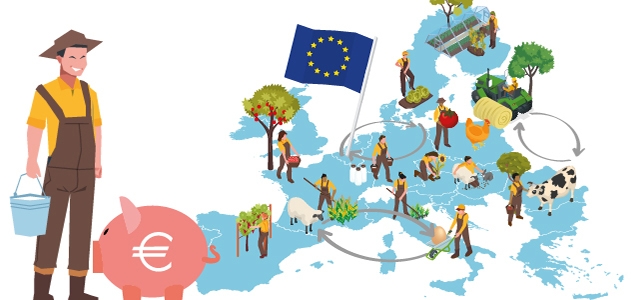
The common agricultural policy (CAP) is a highly complex subject that cannot be reduced to purely technical or budgetary issues. Indeed, with the challenges of food and sustainable development, it is also a social issue. Endowed with stronger environmental ambition at European and national levels, agricultural policy offers the possibility of a transition to less environmentally damaging and more resilient agricultural systems--in a word, an agro-ecology capable of meeting societal expectations for food, health and animal welfare while guaranteeing a decent income for farmers. At a time when the European Commission is reviving debates on the future of CAP, the France Stratégie report examines how to make the CAP a viable lever for the agro-ecological transition.
The CAP: a mixed picture
Introduced in 1962, the CAP's first goal was to increase the productivity, and income of the European agricultural sector based on three main principles: a single market ; a border protection; and a financial solidarity between Member States through the creation of a common budget. And indeed, the CAP has enabled Europe to increase its agricultural production, to ensure its relative food self-sufficiency, and to improve its agri-food trade balance.
With an annual budget of €55 billion, the CAP now accounts for 43% of the European Union's total budget. France receives 16% of this amount, a sum equivalent to its contribution to the total budget of the European Union. Agricultural aid fosters the profitability of farms, and plays an major role as an economic buffer. It represents on average 100% of the current pre-tax income of French farmers.
Yet, as currently practiced, it has come under critricism. Farmers are struggling to make a decent living despite their subsidies ; a quarter of them were living below the poverty line in 2017, according to INSEE. Citizens further criticize the CAP for not supporting those production methods considered most beneficial to the environment and to health. However, agriculture accounts for 20% of greenhouse gas emissions in France, including 71% of methane emissions.
What tools for an "agro-ecological CAP"?
Direct CAP subsidies are linked to farm size and historical production references. This aid considers the environmental issue via "green payment" (30% of direct aid) and "cross compliance". But the use of tools like quotas, thresholds, requirements and derogations limit the environmental effectiveness of the system. Other tools exist that would, however, simplify the CAP, and strengthen its environmental ambitions on an unchanged budget.
Crop rotations preserve soil fertility, reduce phytosanitary risks, and limit the use of chemical inputs. Crop diversification from this perspective could be encouraged through a bonus financed by a tax on fertilizers, pesticides, and persistent antibiotics in the environment. Similarly, grasslands (permanent or natural) contribute to animal nutrition, soil conservation, and carbon sequestration. Therefore, their maintenance could be accompanied by a bonus (or, conversely, a malus in the case of ploughing) financed by a greenhouse gas tax proportional to the number of animals raised.
To encourage the preservation of ecosystems, a bonus might also be paid to farmers who maintain areas of ecological interest--hedges, alignment of trees, ponds,and so forth, together with Natura 2000 areas or high nature value agricultural areas of the Green and Blue Weft. And since engaging in these types of agro-ecological practices comes at a cost, long contracts for agro-ecological innovation (CIAE) could offer support. These three bonuses, and the CIAE, would be financed by a reorientation of the current "other" CAP subsidies, those not falling under either the basic payment entitlements or the green payment.
Finally, rethinking direct aids in a way that makes them proportional to agricultural work rather than to farm size could readily ensure that all farmers receive a minimum payment distinct from the level of agricultural production. At the same time, such aid would take into account the increase in workload involved in switching to agroecological practices. This "basic payment per work unit" would be subject to compliance with the environmental practices required today as part of the green payment, and financed from the current budget for "basic payment entitlements" and the green payment.
Budgetary framework: a long-term target scenario
The implementation of these instruments, therefore, implies a reorganisation of the CAP budget. From the data observed in 2018, and with the CAP budget unchanged, it is possible to estimate the structure of this new CAP, according to a long-term "target scenario". This scenario is not intended to provide a "turnkey solution," but rather to offer a coherent framework for operational decision-making support at European and/or national level.
The central assumption of the target scenario is that the amount of taxes collected covers the amount of bonuses distributed, without requiring a budget increase. The bonus for crop diversification, for instance, estimated at €2.4 billion could be financed by a gradual increase in the tax on fertilisers, as well as pesticides, from a rate of 20% of the price, and the tax on antibiotics from a rate of 15%. These rates correspond to the minimum thresholds necessary to bring about a change in practice. The advantage of progressive taxes is the benefit in time to monitor the impact of environmental indicators, and to allow farmers to adapt their practices.
What would be the effects on the distribution of aid? Not suprisingly, this simulation demonstrates that the crop diversification bonus serves to benefit organic and polyculture-livestock farms that are, themselves, already diversified. The bonus-malus for permanent grasslands, Natura 2000 areas, and areas of high natural value, would strengthen extensive livestock farming. Taxes on pesticides and fertilizers would chiefly profit agro-ecological and organic farms, while taxes on greenhouse gas emissions would impact conventional crops and intensive livestock farming. The simulation shows, moreover, that, to avoid losing subsidies compared with the current situation, field crops with "low or medium agronomic potential" would have to reduce their use of fertilizers and plant protection products by 20%.
Finally, the payment of a basic payment per work unit would make for the consolidation of labour-intensive production, notably tree, vegetable and agro-ecological holdings. The current allocation for basic payment entitlements would allow farmers to receive approximately €8,000 per full-time equivalent job per year.
In the end, this prospective exercise shows that it is possible to strengthen the environmental aims of the CAP, even if it means supplementing them with an additional system of self-financed bonuses at a national level, if it were not possible to reach a European consensus.
Read the full presentation file
Read the report – Making the common agricultural policy a lever of the agro-ecological transition





